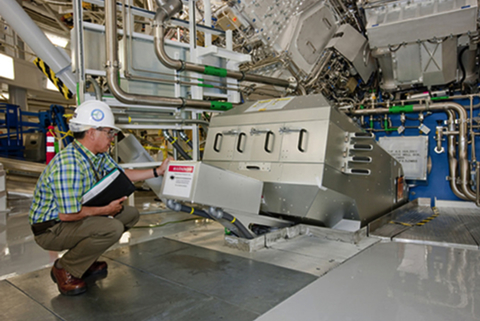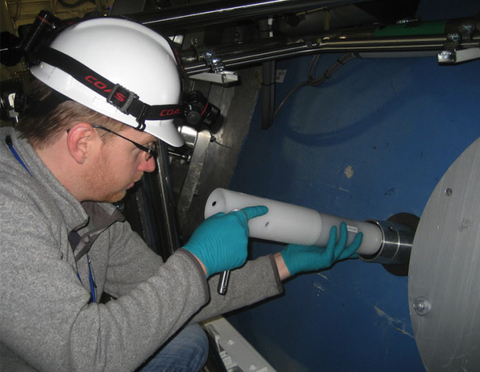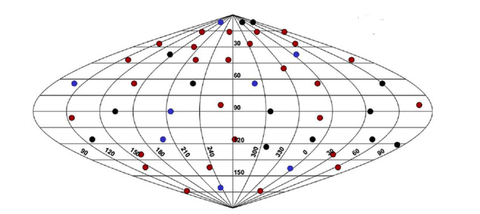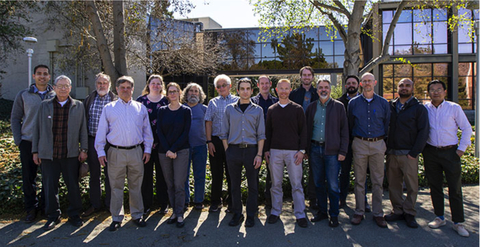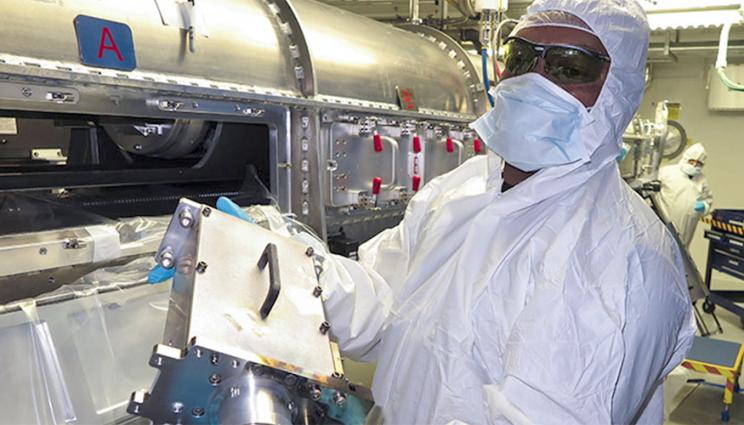
Target area operator Bill Board removes a neutron imager snout from a diagnostic instrument manipulator. The NIF neutron imaging system produces an image of the source distribution of the primary neutrons produced by fusion reactions and the lower energy neutrons that are downscattered in energy by the compressed fuel in an ICF capsule.
At its peak, a NIF inertial confinement fusion (ICF) implosion lasts about 100 trillionths of a second. The imploded fuel is a hundred millionths of a meter in diameter and as much as eight times denser than lead. The center of the imploded capsule is a few times hotter than the core of the sun.
Developing a clear understanding of exactly what's happening in a NIF implosion under those extreme conditions is one of the biggest challenges researchers face as they work toward achieving fusion ignition on the world's largest and highest-energy laser system.
To help meet that challenge, Lawrence Livermore National Laboratory (LLNL) and its partner laboratories and universities have designed and built an extensive suite of more than a dozen nuclear diagnostics, with more on the way.
"What you'd like when diagnosing the implosion is to know everything about the imploding plasma," said LLNL physicist Dave Schlossberg.
"The nuclear diagnostic suite tries to tackle different parameters that you can measure independently," he said. "The neutron imaging system measures the spatial distribution of the implosion. Neutron time-of-flight diagnostics measure average energy and drift velocity. And gamma reaction history measures emission with respect to time. By assembling that information, we piece together a better picture of what's going on in the implosion."
"Some of the diagnostics 'cross-talk' with each other," added physicist Kelly Hahn. "Some provide different pieces (of information), some have similar pieces and we can bring them all together to assemble a more comprehensive picture. If you want to achieve ignition, nuclear diagnostics are crucial."
Clues to performance
Among the key factors that provide clues to implosion performance are the neutron yield, the ion (plasma) temperature and the downscatter ratio - the ratio between the number of high-energy neutrons and lower-energy neutrons that have been scattered through interactions with the hydrogen isotopes in the fuel, an indication of fuel density and distribution of the cold fuel surrounding the hot spot.
Also important are bang time - the time of peak neutron emission that characterizes the speed of the implosion - and burn width, the length of time the implosion is producing neutrons.
All these parameters, and others, are assessed by nuclear diagnostics.
"The nuclear diagnostics basically are the only diagnostics that are really measuring the fuel density and temperature," said Nuclear Diagnostics Group Leader Alastair Moore. "And they're completely critical to understanding how well we assembled the fuel and how close to ignition we are."
In NIF ICF experiments, up to 192 powerful laser beams heat a cylindrical X-ray "oven" called a hohlraum. The X-rays compress the hydrogen isotopes, deuterium and tritium (DT), partially frozen inside a tiny capsule suspended within the hohlraum. If the density and temperature are high enough and last long enough, the fuel will ignite and generate a self-sustaining thermonuclear reaction that spreads through the fuel and releases a large amount of energy, primarily in the form of high-energy neutrons.
The implosion process creates temperatures and pressures similar to those found inside stars, giant planets and nuclear detonations. NIF is a key component of the National Nuclear Security Administration's Stockpile Stewardship Program, and experiments on NIF advance scientific research into high energy density (HED) science including astrophysics, materials science and ICF.
Unknown unknowns
A particular value of NIF's nuclear diagnostics is their ability to help answer questions that researchers didn't even know they had - what scientists call "unknown unknowns."
Recently, for example, the array of four neutron time-of-flight detectors positioned around the target chamber revealed that the tiny hot spot at the center of the implosion was drifting at a speed of about 100 kilometers per second - an indication of implosion asymmetry, a major cause of degraded performance.
"We originally had two spectrometers," said physicist Ed Hartouni, "and adding a third spectrometer gave us the capability to see motion and to measure the drift velocity of the hot spot, which was not expected at all. It actually took quite some time to be accepted, this interpretation of what these detectors were telling us.
"They revealed something that was going on in the implosion that we didn't anticipate, that nobody had expected," he said. "That the hot spot could move - it was quite surprising."
"We actually have a fifth spectrometer coming on line," noted Moore, "which will give us an even better ability to understand whether the hot spot is moving because we've driven it asymmetrically, or because the capsule is asymmetric, or the hohlraum is asymmetric. All these failure modes that can lead to poor implosion performance can be diagnosed directly by having multiple spectrometers looking at the same implosion."
Click here for descriptions of other primary nuclear diagnostics.
And that's not all. In a collaboration led by the Los Alamos National Laboratory (LANL) Neutron Imaging Team, researchers from LANL, LLNL and the Laboratory for Laser Energetics (LLE) at the University of Rochester recently added a third neutron imaging system, NIS3, designed to provide a 3D image showing the size and shape of the burning DT plasma during the ignition stage of an implosion.
The hot-spot size and fuel asymmetry are determined from the image of the primary, or high-energy, neutrons, and the cold fuel areal density, known as rho-R, is inferred from the downscatter ratio. Areal density is an important factor in the final configuration of the fuel for obtaining ignition and fusion burn.
"As NIF moves toward higher performance, understanding the three-dimensional nature of these implosions becomes critical," said LLNL physicist David Fittinghoff. "With the two previous neutron imaging sight lines (on the equator and the north pole of the target chamber) we had to make an assumption about the symmetry of the implosion.
"Now with the new NIS3 we have three orthogonal lines of sight with which to reconstruct a volume of fusing plasma," he said. "An analogy might be the difference between seeing a painting of a man and actually walking around his sculpture."
Along with improving neutron imaging, NIS3 also provides a line of sight for imaging gamma rays produced by inelastic scattering of the fusion neutrons from carbon in the target capsule material remaining during an implosion. This could help researchers determine the amount and effect of the mixing of capsule material with the fusion fuel, a known source of performance degradation.
Yet another major diagnostics upgrade was completed in 2017 with the installation of an array of 48 real-time neutron activation detectors, or RT-NADs, at strategic locations around the target Chamber.
Earlier NADs, called flange NADs, worked when unscattered neutrons activated a sample of zirconium. The activated samples were removed from the chamber and the activation level was determined using nuclear counting techniques elsewhere on the site. Activation of the real-time NAD detectors is monitored in situ, providing better sampling of the angular distribution of the unscattered neutron yield with much more rapid turnaround and at a significantly lower operating cost.
The system provides near real-time time determination of the neutron fluence distribution. It operates over two to three orders of magnitude of neutron yield, providing overall yield estimates precise to 2 percent or better.
"Neutron yield varies around the chamber because you have different thicknesses of the fuel in the compressed core of the explosion," Moore explained. "RT-NADs is primarily a way for telling how the fuel is distributed around the hot spot when the capsule goes bang."
"It has twice the number of detectors and five times the sensitivity" of the flange NADs system, noted diagnostic physicist Richard Bionta, responsible scientist for the RT-NADs system. "In the old system, we only had one detector. Each of the 20 pucks were placed in the detector one at a time, so that took five days to go through. (The RT-NADs) are certainly a lot better than the way we used to do it."
"Richard spent more than two years developing the capability to manage that stream of data," added Moore. "You've got 48 detectors that are reading out every 10 minutes and producing terabytes of data. You try to analyze that and piece that picture back together again, of what happened with the shot."
Along with Moore, Schlossberg, Hahn, Hartouni, Fittinghoff and Bionta, members of the nuclear diagnostics team include Shaun Kerr, Justin Jeet, Mark Eckart, Gary Grim, Eddie Mariscal, Jorge Carrera, Edwin Casco, Cory Waltz, David Barker, Wenhai Yang, Charles Yeamans, Jack Caggiano, Dan Sayre, Robert Hatarik, Darren Bleuel and Jon Gjemso from LLNL; Petr Volegov, Carl Wilde, Valerie Fatherley, Justin Jorgenson, Lynn Goodwin, Kevin Meaney, Yongho Kim, Hermann Geppert-Kleinrath, Hans Hermann and Verena Geppert-Kleinrath from LANL; Vladimir Glebov, Chad Forrest, Hans Rinderknecht and Jim Knauer from LLE; Maria Gatu-Johnson, Neel Kabadi, Johan Frenje and Brandon Lahmann from MIT; Michael Rubery from the UK's Atomic Weapons Establishment; and LLNL summer intern Joey Gordon, now a graduate student at UC Berkeley.
Other primary NIF nuclear diagnostics
- Neutron time-of-flight (nTOF) detectors (developed by LLNL and LLE) measure the time of flight of neutrons emitted from the target. The arrival time at the detector provides the neutron energy, and the spread of arrival times is related to the ion temperature of the hot spot. The difference between expected and actual arrival time provides the hot-spot drift velocity. nTOFs also measure neutron yield and areal density.
- The neutron imager time-of-flight (NITOF) (LANL/LLNL) measures neutron yield, ion temperature and areal density along the neutron imaging system line of sight.
- Well-NAD nuclear activation detectors provide the yield of record for high-yield NIF shots. Three zirconium pucks are fielded in the low-scattering environment inside the target chamber. Well-NAD measurements are also used to calibrate the RT-NADs and other diagnostics.
- The magnetic recoil spectrometer (MRS) (MIT, LLE, LLNL) is a neutron spectrometer used to infer the neutron energy spectra (neutrons as a function of their energy) and neutron yield. Neutrons interact with a plastic foil held 26 centimeters from the target, producing knock-on protons or deuterons. These charged particles are then energy-dispersed by their momentum in a magnetic field and focused on an array of solid plastic film track detectors located at the focal point of the spectrometer. After a shot, the film is removed and etched and the neutron spectrum and yield are determined by the location and number of tracks on the detector films.
- The gamma reaction history (GRH) diagnostic (LANL, LLNL) measures nuclear bang time and burn width by determining the spectrum and time history of the emission of target-produced gamma rays. In each of the four GRH spectral channels, gammas interact with a foil to produce Compton electrons, which recoil into a gas-filled cell. These electrons generate broadband Cerenkov light if their velocity exceeds the local speed of light as determined by the type and pressure of the gas in the cell. For each channel, Cerenkov light is relayed to a high-speed detector using an off-axis parabolic mirror. The GRH also measures the absolute level of DT gamma-ray emission and helps determine the amount of ablator material remaining in the compressed capsule through observation of gamma rays from the interaction of the fusion neutrons with the carbon shell.
- The gas Cherenkov detector (GCD) (LANL, LLNL, AWE) provides precision measurements of reaction history and ablator areal density history. The latest generation (GCD-3) utilizes pulse-dilation photomultiplier tube technology from Sydor Technologies of Rochester, New York, that will allow for enhanced (10-picosecond) temporal resolution that could make features such as the onset of alpha heating, shock reverberations and burn truncation due to dynamically evolving failure modes visible for the first time.
- Charlie Osolin

